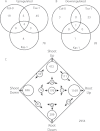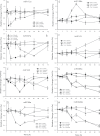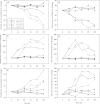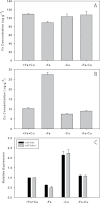Rosette iron deficiency transcript and microRNA profiling reveals links between copper and iron homeostasis in Arabidopsis thaliana
- PMID: 22962679
- PMCID: PMC3467300
- DOI: 10.1093/jxb/ers239
Rosette iron deficiency transcript and microRNA profiling reveals links between copper and iron homeostasis in Arabidopsis thaliana
Abstract
Iron (Fe) is an essential plant micronutrient, and its deficiency limits plant growth and development on alkaline soils. Under Fe deficiency, plant responses include up-regulation of genes involved in Fe uptake from the soil. However, little is known about shoot responses to Fe deficiency. Using microarrays to probe gene expression in Kas-1 and Tsu-1 ecotypes of Arabidopsis thaliana, and comparison with existing Col-0 data, revealed conserved rosette gene expression responses to Fe deficiency. Fe-regulated genes included known metal homeostasis-related genes, and a number of genes of unknown function. Several genes responded to Fe deficiency in both roots and rosettes. Fe deficiency led to up-regulation of Cu,Zn superoxide dismutase (SOD) genes CSD1 and CSD2, and down-regulation of FeSOD genes FSD1 and FSD2. Eight microRNAs were found to respond to Fe deficiency. Three of these (miR397a, miR398a, and miR398b/c) are known to regulate transcripts of Cu-containing proteins, and were down-regulated by Fe deficiency, suggesting that they could be involved in plant adaptation to Fe limitation. Indeed, Fe deficiency led to accumulation of Cu in rosettes, prior to any detectable decrease in Fe concentration. ccs1 mutants that lack functional Cu,ZnSOD proteins were prone to greater oxidative stress under Fe deficiency, indicating that increased Cu concentration under Fe limitation has an important role in oxidative stress prevention. The present results show that Cu accumulation, microRNA regulation, and associated differential expression of Fe and CuSOD genes are coordinated responses to Fe limitation.
Figures









Similar articles
-
Use of natural variation reveals core genes in the transcriptome of iron-deficient Arabidopsis thaliana roots.J Exp Bot. 2012 Jan;63(2):1039-55. doi: 10.1093/jxb/err343. Epub 2011 Oct 30. J Exp Bot. 2012. PMID: 22039296 Free PMC article.
-
Transcriptome sequencing identifies SPL7-regulated copper acquisition genes FRO4/FRO5 and the copper dependence of iron homeostasis in Arabidopsis.Plant Cell. 2012 Feb;24(2):738-61. doi: 10.1105/tpc.111.090431. Epub 2012 Feb 28. Plant Cell. 2012. PMID: 22374396 Free PMC article.
-
New aspects of iron-copper crosstalk uncovered by transcriptomic characterization of Col-0 and the copper uptake mutant spl7 in Arabidopsis thaliana.Metallomics. 2018 Dec 12;10(12):1824-1840. doi: 10.1039/c8mt00287h. Metallomics. 2018. PMID: 30460953
-
All together now: regulation of the iron deficiency response.J Exp Bot. 2021 Mar 17;72(6):2045-2055. doi: 10.1093/jxb/erab003. J Exp Bot. 2021. PMID: 33449088 Free PMC article. Review.
-
Copper and iron homeostasis in plants: the challenges of oxidative stress.Antioxid Redox Signal. 2013 Sep 20;19(9):919-32. doi: 10.1089/ars.2012.5084. Epub 2013 Jan 23. Antioxid Redox Signal. 2013. PMID: 23199018 Free PMC article. Review.
Cited by
-
Identification of jasmonic acid-associated microRNAs and characterization of the regulatory roles of the miR319/TCP4 module under root-knot nematode stress in tomato.J Exp Bot. 2015 Aug;66(15):4653-67. doi: 10.1093/jxb/erv238. Epub 2015 May 22. J Exp Bot. 2015. PMID: 26002970 Free PMC article.
-
Alkaline stress and iron deficiency regulate iron uptake and riboflavin synthesis gene expression differently in root and leaf tissue: implications for iron deficiency chlorosis.J Exp Bot. 2016 Oct;67(19):5671-5685. doi: 10.1093/jxb/erw328. Epub 2016 Sep 7. J Exp Bot. 2016. PMID: 27605716 Free PMC article.
-
Regulation of Iron Homeostasis and Use in Chloroplasts.Int J Mol Sci. 2020 May 11;21(9):3395. doi: 10.3390/ijms21093395. Int J Mol Sci. 2020. PMID: 32403383 Free PMC article. Review.
-
Conserved Cu-MicroRNAs in Arabidopsis thaliana Function in Copper Economy under Deficiency.Plants (Basel). 2019 May 29;8(6):141. doi: 10.3390/plants8060141. Plants (Basel). 2019. PMID: 31146453 Free PMC article.
-
miRNA-based heavy metal homeostasis and plant growth.Environ Sci Pollut Res Int. 2017 Apr;24(11):10068-10082. doi: 10.1007/s11356-017-8593-5. Epub 2017 Feb 22. Environ Sci Pollut Res Int. 2017. PMID: 28229383 Review.
References
-
- Beauclair L, Yu A, Bouche N. 2010. microRNA-directed cleavage and translational repression of the copper chaperone for superoxide dismutase mRNA in Arabidopsis The Plant Journal 62 454––462 - PubMed
-
- Bonnet E, He Y, Billiau K, Van de Peer Y. 2010. TAPIR, a web server for the prediction of plant microRNA targets, including target mimics Bioinformatics 26 1566––1568 - PubMed
MeSH terms
Substances
LinkOut - more resources
Full Text Sources
Other Literature Sources
Medical
Molecular Biology Databases

